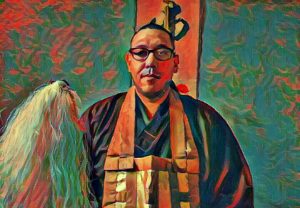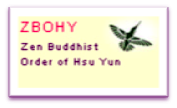Nienfo Chan/Nembutsu Zen is the most common practice taught in China to enter the gateless gate of Zen. It consists “simply” in the recitation of a sacred or symbolic name, such as the name of a Buddha or a mantra. Such a practice is a popular form of devotion for simple and helpless people in need of refuge, but it is much more. Please don’t be fooled by the simplicity of the practice, it is a wonderful Dharma raft.
This recitation practice fits all situations, and all spiritualities. It is a blessing that matches the Linji/Rinzai mindset of always giving the mind what it needs. My late Dharma teacher MingZhen Shakya used to say:
Always, give the mind what it needs to enter the gateless gate.’
Recitation is a universal Buddhist practice found in Mahayana and Theravada Buddhism. The roots of the practice come from BuddhaSmriti (mindful awareness). The practitioner recollects the Buddha’s name. It is as simple and beautiful as that.
There are different intentions the practitioner may have when doing the practice. But the main intention is to harmonize the intention with what the mind needs. If I am standing in the middle of a crowded train, for example, the intention needed may be a peaceful mind. I may need to dispel the irritation of noise or the smell of the underground cars. Recitation is a wonderful practice. I shift away from reacting to the situation to resting on Buddha’s name in mindful awareness.
There are many levels and ways to cultivate the practice of recitation. The old Chinese booklet “48 Doors to Nienfo,” also titled Taming the Monkey Mind is a good resource. This small booklet allows the reader to enter into the realm of the practice of Hua t’ou.
There is no fundamental difference between practices, one practice leads to another. The key is attention. You need to pay attention when you recollect the Buddha’s name. Attention to practice leads to Pure Mind.
The same principle is true for the four main practices we share in our Sangha. To sum it up these are: 1. Recitation, 2. Huatou/Wato, 3. GuanYin Chan/Kannon Zen, 4. MoChao Chan/Mokusho Zen.
Our usual set of mind is a mind of delusion , always trapped in a view, a craving or dissatisfaction. It is like a man walking around a mountain in a fog. He is unable to see the mountain, let alone a path leading up the mountain.
When we see the mountain and the path up the mountain, we have a chance to escape our suffering. With attention we begin to climb the difficult path of concentration. We set our mind on the summit; the Spiritual Everest of most traditions. In our Zen Linji/Rinzai school, we call this Kensho or JianXin, seeing mind. What all zen ancestors urged for.
It has many names: paradise, knowing God, entering the bride’s room, meeting sky father, Oneness, death of the self and the brilliant presence of a true Self. A Buddha Nature of non difference, an emptiness made form or form made emptiness.
In our Chinese tradition, it is Amituofo which means the Buddha of Pure Light beyond Space and Time. It is the summit for a devotee. We call it “Unified/Union Mind” or a a Mind in Samadhi/Zen. This experiences is beautiful and very inspiring, but it is not the end of the path.
To the contrary it is the very beginning of the path! Every practice towards Samadhi’s Egoless state before kensho isn’t called Zen. Before samadhi the work of these practices is to bring you to the door of Zen, our most natural state.
We acknowledge these experiences knowing that the heart of our practice is to give. We don’t dwell in Samadhi, apart from society in a dreamlike state. It’s a trap easy to fall into a path of the Buddhahood for ourselves. Shakyamuni himself doubted his capacities to share what he knew. The story goes that Brahma begged him to teach those with little dust in their eyes.
So, the specificity of Zen is to be a Traceless Path. The fourth Mind is the traceless mind or No mind, Wu/Mu Xin. Big word you might say, what does it mean.
It means a path of traceless manifested of our true self.
Once we understand Union/Samadhi/kensho is not the end of the path we we offer what we have to offer to others. We let the sacred manifest and we let ourselves manifest the Union in our daily lives. If there is kensho wonderful, if it’s a day of no kensho wonderful too. Our way is Farming Chan/Zen as Fo Yuan Shakya, our grandfather in the Yunmen/Ummon lineage used to say.
When we try to force the union with the Godhead through acts such as trying to follow the 3 pure precepts (do no harm, cultivate goodness, purify the mind) we end up manifesting the little self. This deliberate attempt is a mind of manifestation with traces of our little self wanting to do good. It’s not a bad thing per se but it is not the manifestation of union. When we are harmonious and we follow the three pure precepts without effort. It is traceless.
In our Order, Zen priests practice in small households. Our Zen practice is house cleaning and baths for the kids, as well as Zen liturgy, zazen or sewing. Every action can be a field where we manifest the path.
Our Order is a grounded expression of the four noble truths and the Eightfold Path. We summarize it as Right View-Right Action. Ming Zhen, my Old Sun hated spending time on nonsense talk of karma and rebirth. She would be more likely to say,
Zen is Action, Action is Karma! Wake Up!”
Amituofo!
Amituofo!
Amituofo!
Fǎshī yáo xìng Shakya

The Zen Buddhist Order of Hsu Yun: Zen and The Martial Arts isn’t a blog. A problem that could use some Zen elucidation will get the needed attention. Contact us at yao.xiang.editor@gmail.com.
Remember, the Path’s two important rules: Begin and Continue.
Print This Page


